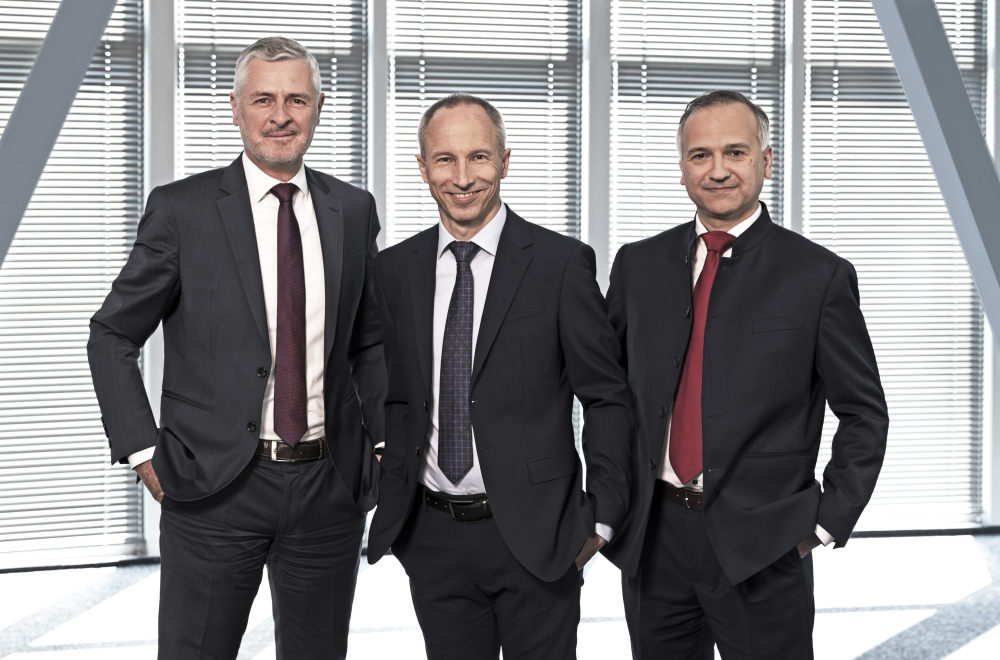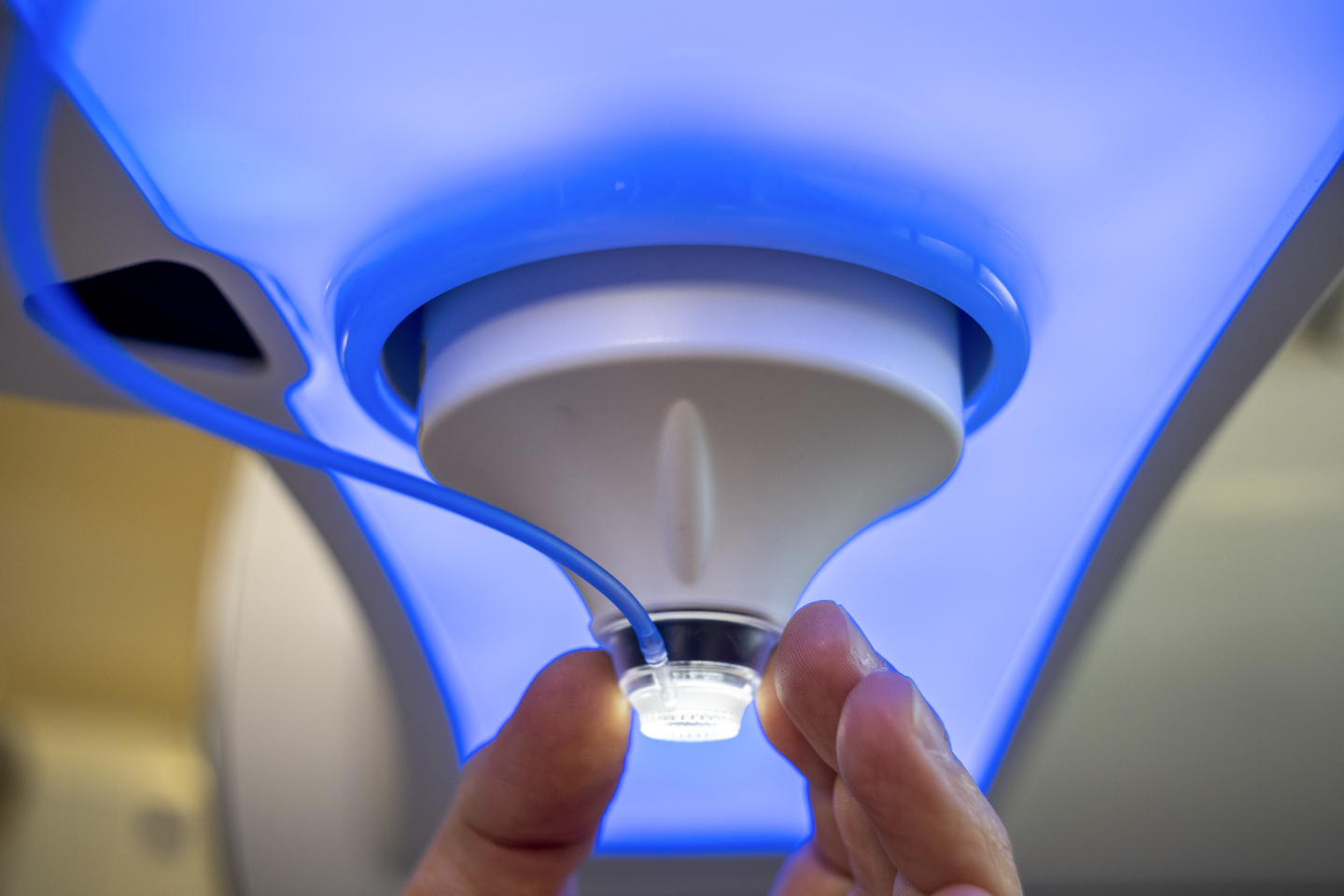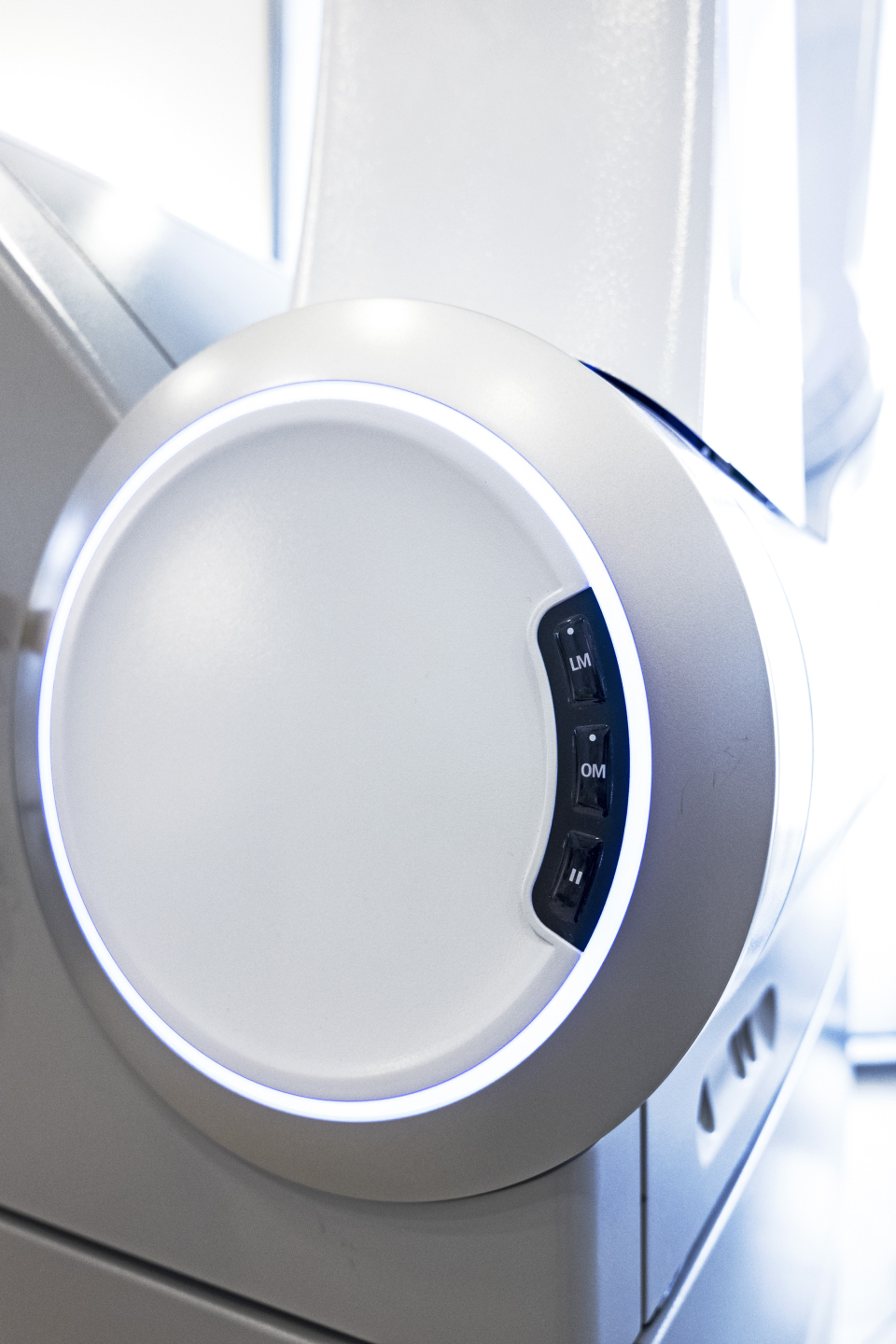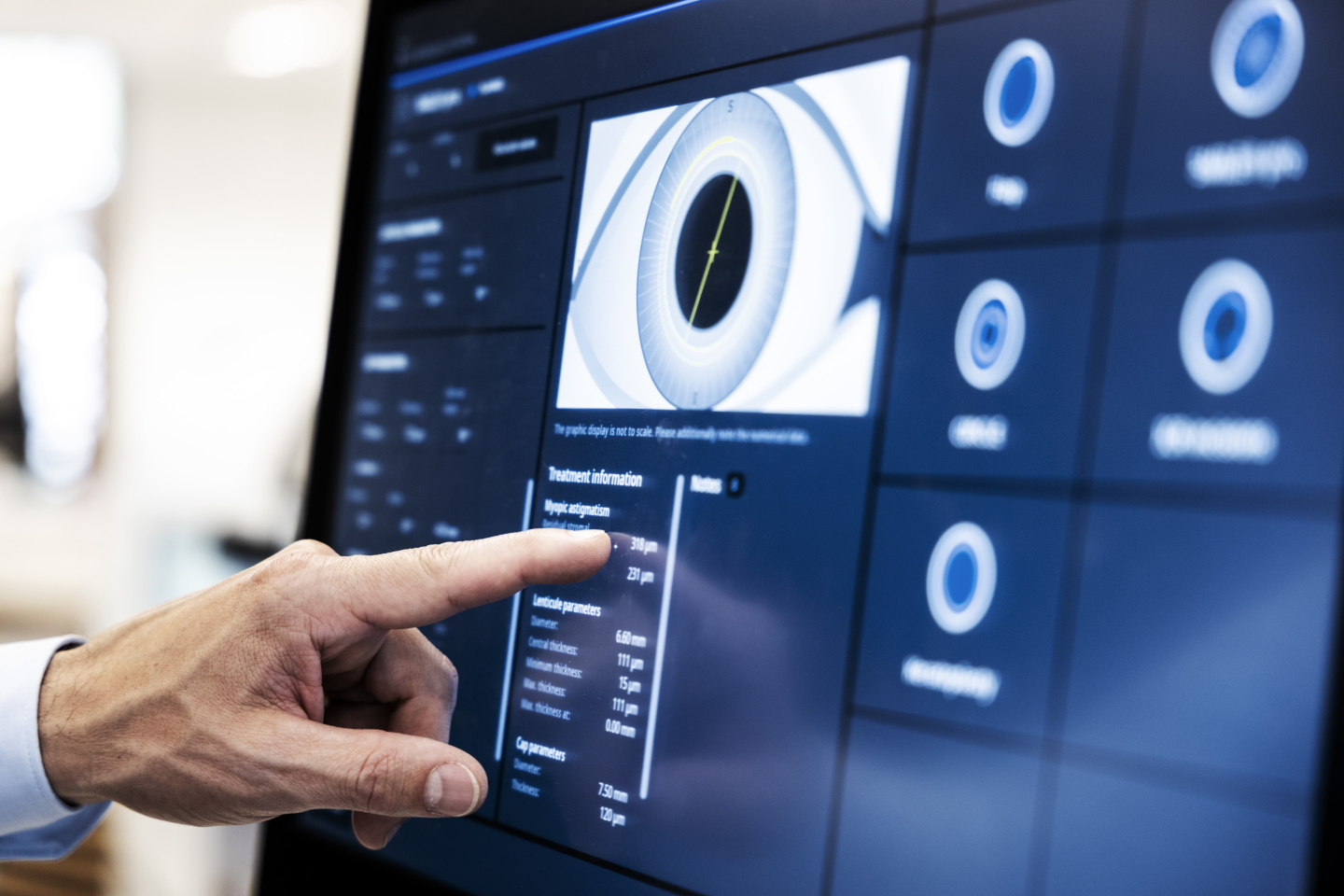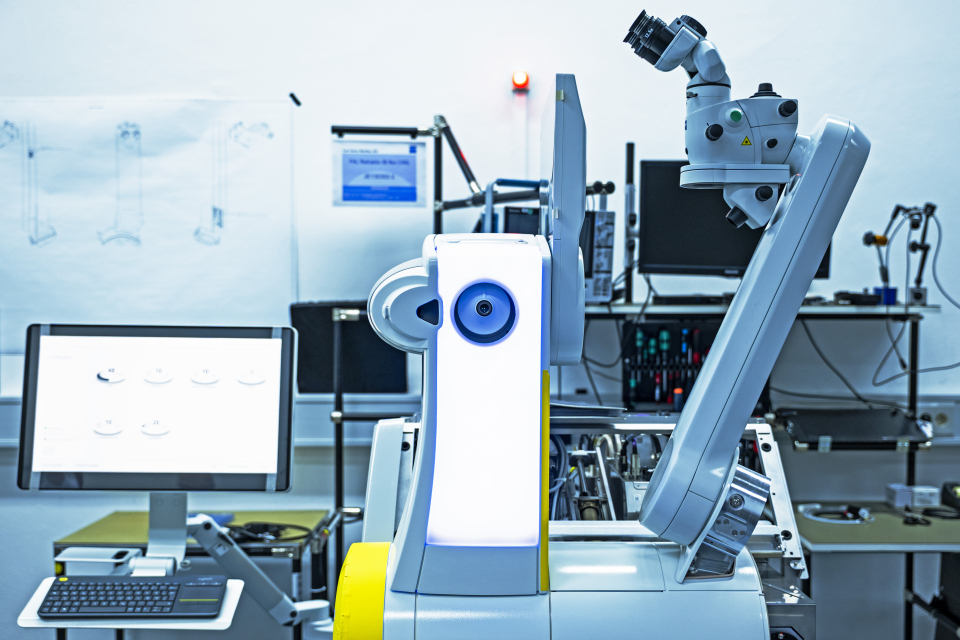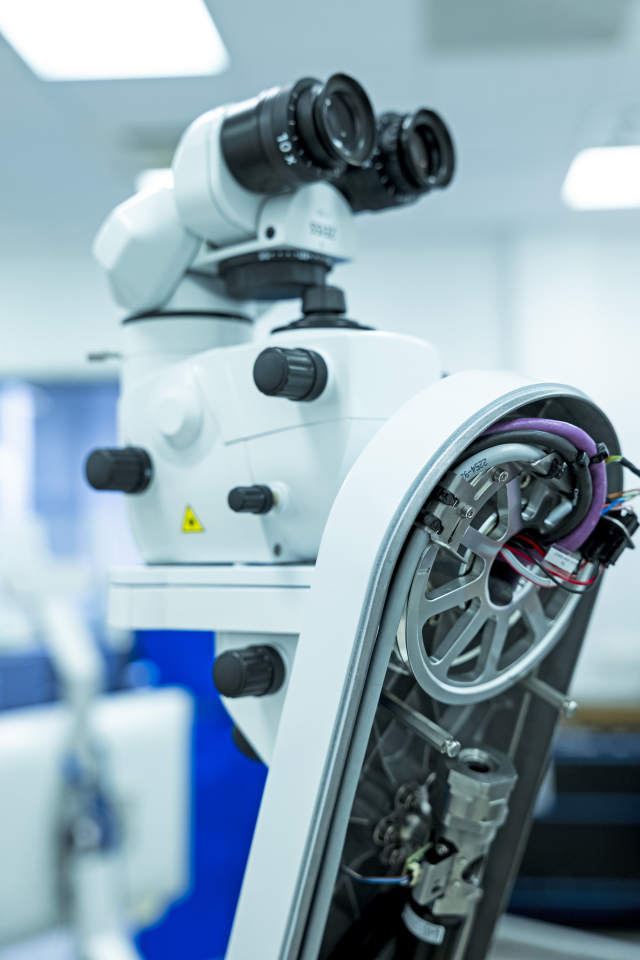Nominee 2025
Vision correction for millions of people
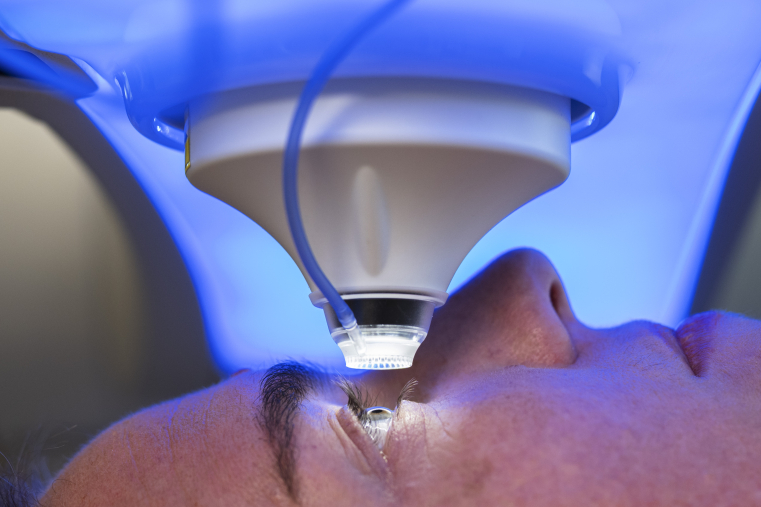
Ideally, our eye is a finely tuned optical system that functions with precision: light first hits the cornea, passes through the lens and is finally projected onto the retina. Here, the photoreceptors convert the light into nerve impulses that are transmitted via the optic nerve to the brain, which processes the information and translates it into a complete image. If the geometry of the eye is not correct because the eyeball is too long for the curvature of the cornea, for example, a blurred image is produced. Glasses or contact lenses compensate for this. But what if poor vision could also be corrected in a minimally invasive and permanent way?

Dr. Mark Bischoff, Dr. Gregor Stobrawa, Dirk Mühlhoff and their team at Carl Zeiss Meditec AG have achieved exactly that: they have developed the minimally invasive procedure of lenticule extraction as well as the high-precision technology required for it and revolutionized laser eye surgery.
More Details
Resume
Dr. rer. nat. Mark Bischoff
23.03.1972
Born in Erfurt, Germany
1990 – 1995
Graduate studies in Physics at Friedrich Schiller University Jena, Germany
Diploma in Physics, specialization in Laser Physics1995 – 1999
Ph.D. student and research assistant at the Institute of Optics and Quantum Electronics, Friedrich Schiller University Jena
2000
Ph.D. from Friedrich Schiller University Jena, thesis on ultrafast spectroscopy on plant photoreceptor proteins
2000 – 2001
Research Scientist at the R&D department for femtosecond fiber-lasers at IMRA America, Inc. in Ann Arbor, MI, USA
2001 – 2002
Post-Doctoral Scientist at the Institute for Optics and Quantum Electronics, Friedrich Schiller University Jena, research on a laser-based plasma source for EUV radiation
2002 – 2004
Developer in the project for the femtosecond laser system VISUMAX and the lenticule extraction method at Carl Zeiss Meditec AG, Jena
2004 – 2006
Project Leader of the development project for the femtosecond laser system VISUMAX and the lenticule extraction method at Carl Zeiss Meditec AG, Jena
2006 – 2008
Head of Systems Engineering for Refractive Lasers at Carl Zeiss Meditec AG, Jena
2008 – 2016
Head of Research and Development for Refractive Lasers at Carl Zeiss Meditec AG, Jena
2016 – 2020
Head of Application Research for Refraktive Lasers at Carl Zeiss Meditec AG, Jena
Since 2021
Head of Tissue Engineering at the Corporate Research and Technology Department of Carl Zeiss AG, Jena
Patents
More than 500 patent applications published in over 70 patent families
Publications
12 publications in scientific journals and books
Dr. rer. nat. Gregor Stobrawa
16.08.1974
Born in Rudolstadt, Germany
1993 – 1998
Graduate studies in Physics at Friedrich Schiller University Jena, Germany
Diploma in Physics, specialization in Ultrafast Spectroscopy1998 – 2003
Ph.D. student and research assistant at the Institute of Optics and Quantum Electronics, Friedrich Schiller University Jena
2003
Ph.D. from Friedrich Schiller University Jena, thesis on technology and application of a pulse shaper for ultrashort laser pulses
2003 – 2004
Post-Doctoral Scientist at the Institute for Optics and Quantum Electronics, Friedrich Schiller University Jena
2004 – 2007
Developer in the project for the femtosecond laser system VISUMAX and the lenticule extraction method at Carl Zeiss Meditec AG, Jena
2007 – 2012
Project Leader of the development project for the femtosecond laser system VISUMAX and the lenticule extraction method at Carl Zeiss Meditec AG, Jena
2012 – 2016
Head of Systems Engineering for Refractive Lasers at Carl Zeiss Meditec AG, Jena
2016 – 2023
Head for Development Program for Refraktive Femtosecond Lasers at Carl Zeiss Meditec AG, Jena
Since 2023
Head of Workflow Development for Refractive and Therapeutic Treatments at Carl Zeiss Meditec AG, Jena
Patents
More than 350 patent applications published in over 55 patent families
Publications
16 publications in scientific journals and books
Dipl.-Phys. Dirk Mühlhoff
09.09.1970
Born in Gummersbach, NRW, Germany
1990 – 1996
Studies of Physics at RWTH Aachen, Germany
Diploma thesis at Fraunhofer Institute Laser Technology;
Department Diode-Pumped Solid State Laser
Degree: Diploma1996 – 2002
Research Staff and Head of Life Sciences working group
Carl Zeiss Jena GmbH, Corporate Research
Projects on laser-scanning ophthalmoscopy and fiber laser technology2002 – 2010
Various positions in Research & Development
Carl Zeiss Meditec AG; Business Unit Ophthalmic Devices
Starting position 2002-2004: project manager, thereafter Head of R&D;
Development of the femtosecond-laserkeratome VISUMAX and the surgical procedure SMILE (Small Incision Lenticule Extraction)2007 – 2008
Part-time studies at University of Augsburg, Germany
Degree: Master of Business Administration (MBA)2010 – 2025
Head of Business Sector Refractive Laser
Carl Zeiss Meditec AG
Approval and market introductions of the laser-surgical product portfolio.
Directing the clinical and technological development of VISUMAX 800Since 2025
Managing Director MLase GmbH
Development and manufacturing of excimer lasers for medical applications in ophthalmology and laser-atherektomy
Other activities
2015 – 2025
AECOS American-European Congress of Ophthalmic Surgery Member of the European Executive Committee
Since 2025
Allotex S.P.A.
Development of allogenic collagen implants for the correction of presbyopia
Member of Board of Directors
Patents
56 patent families in the areas of laser-scanning ophthalmoscopy, digital projection technology and refractive surgery
Contact
Coordination and Press
Dr. Janine Luge-Winter
Carl Zeiss Meditec AG
Group Communications
Göschwitzerstrasse 51-52
07745 Jena, Germany
Phone: +49 (0) 364 / 12 20 335
E-Mail: janine.luge-winter@zeiss.com
Web: www.zeiss.com/med
Spokesperson
Dr. Mark Bischoff
Carl Zeiss AG
Head of CRT-GT, Corporate Research and Technology
Carl-Zeiss-Promenade 10
07745 Jena
Mobile: +49 (0) 151 / 16 77 43 56
E-Mail: mark.bischoff@zeiss.com
Web: www.zeiss.de
A description provided by the institutes and companies regarding their nominated projects
Vision correction for millions of people - ultra-short light pulses permit minimally invasive laser eye surgery
Our eyes are the most crucial of our senses. We can use them to distinguish millions of colors;1 and recognize things that are incredibly far away, like the stars in the night sky or tiny details like the fine patterns on a butterfly's wing. Good vision is a prerequisite for moving safely in your surroundings and freely when coming into contact with others. Nevertheless, intensive reading and writing in school and university and near vision tasks when using smartphones, PCs and TVs, combined with a person's genetic predisposition, are causing an increased instance of myopia among young people and young adults worldwide. Although correcting ametropia with glasses or contact lenses is commonplace, having to use them can also be perceived as annoying or unpleasant especially when working with safety goggles, during sports, during outdoor activities or if an elderly person forgets their reading glasses.
Dr. Mark Bischoff, Dr. Gregor Stobrawa and Dirk Mühlhoff head up the team that has developed a femtosecond laser keratome (VISUMAX®) that makes three-dimensional incisions in a human cornea with maximum precision and unprecedented speed. The medical femtosecond laser allows the surgical procedure for lenticule extraction (SMILE®) that the team also developed. This allows eye surgeons to correct an existing ametropia2 with minimal invasiveness.
Laser vision correction with ultra-short light pulses
The first ideas and attempts at surgical correction of visual impairments had already begun as far back as the middle of the last century and became popular worldwide because specialized medical laser devices became available at the beginning of the 1990s.3 Laser in-situ keratomileusis (LASIK) is the best-known procedure. In the first stage of this method of laser vision correction, a "corneal flap" is created using a surgical knife or a medical femtosecond laser. The top layer of the cornea or "flap" is partially loosened so that after folding it back the actual correction of the corneal refractive power on the underlying tissue can be performed with a medical excimer laser. The ZEISS development team was intent on creating a less invasive procedure using only one medical laser device.
The ZEISS team of developers combined a femtosecond laser with special high-performance optics and modern computer control. The medical device calculates and generates the laser incisions necessary for lenticule extraction in the cornea with the required precision in accordance with the parameters set by surgeons. Two million ultra-short laser pulses (lasting less than one millionth of a millionth of a second) with micrometer accuracy (1 micrometer = 1/1000-th of a millimeter) are positioned in the cornea per second in such a way that all the incisions required for the procedure can be made there in less than 10 seconds.
In order to prevent any movement, the procedure initially involves fixing the eye to the ZEISS femtosecond laser using a sterile contact element. A lenticule inside the cornea is then separated by the laser device and a small incision is made. The surgeon removes the lenticule through this incision, which changes the curvature of the front surface of the cornea and thus corrects the refractive error. The incision, which is just a few millimeters wide, closes within a few hours.
Minimally invasive vision correction for millions of people
Every year, more than 50 million people worldwide reach adulthood with refractive errors that require correction, putting an end to the growth of their eyes. From this point on, most of them were able to be treated with a laser correction procedure. The main reason people refrain from undergoing laser surgery is because they are worried about possible complications and side effects. In the case of lenticule extraction with a femtosecond laser from ZEISS, clinical studies did not simply demonstrate the utmost accuracy of vision correction, they also show that this minimally invasive procedure cuts very few of the nerves in the cornea, significantly reducing the side effects of the "dry eye" that can occur with a corneal flap. In addition, a possible subsequent displacement of the flap due to the application of mechanical force (e.g. eye rubbing, swimming) can be practically ruled out. 4,5 The minimally invasive lenticule extraction is therefore particularly beneficial for those groups in professions where the need for good vision is great and for people who play a lot of sports.6
This minimally invasive lenticule extraction procedure using a ZEISS femtosecond laser was first performed on a human being in 2007 as part of a clinical study conducted by Carl Zeiss Meditec AG in Germany.7 In 2011, the (SMILE® Technology with VISUMAX®) procedure received clinical approval in the European Union and, in 2018, it was approved by the US Food and Drug Administration (FDA). In 2024, lenticular extraction with the latest generation of ZEISS femtosecond lasers received clinical approval in the EU for people with hyperopia – a patient group that previously could not be treated with this minimally invasive procedure. Worldwide, surgeons have treated more than 12 million eyes to date using the lenticule extraction method and femtosecond laser developed by ZEISS.
About Carl Zeiss Meditec AG
Carl Zeiss Meditec AG (ISIN: DE0005313704) is one of the world’s leading medical technology companies and is listed on the German MDAX and TecDax stock indices.The company supplies innovative technologies and application-oriented solutions designed to help doctors improve the quality of life of their patients. It provides complete packages of solutions for the diagnosis and treatment of eye diseases, including implants and consumables. In microsurgery, the company provides innovative visualization solutions. With 5,730 employees worldwide, the Group generated revenue of €2,066.1m in fiscal year 2023/24 (to 30 September).
The Group’s head office is located in Jena, Germany. It has subsidiaries in Germany and abroad; more than 50 percent of its employees are based in the United States, Japan, Spain and France. The Center for Application and Research (CARIn) in Bangalore, India, and the Carl Zeiss Innovations Center for Research and Development in Shanghai, China, strengthen the company's presence in these rapidly developing economies. Around 39 percent of Carl Zeiss Meditec shares are in free float. Around 59 percent are held by Carl Zeiss AG, one of the world’s leading companies in the optical and optoelectronic industries.
Weitere Informationen unter: www.zeiss.de/med
[1] https://www.aao.org/eye-health/tips-prevention/how-humans-see-in-color#:~:text=They%20reflect%20wavelengths%20of%20light,up%20to%2010%20million%20colors. [2] Myopie bis -10 Dioptrien als auch Hyperopie bis +6 Dioptrien, ohne und mit Astigmatismus bis -5 Dioptrien [3] J. I. Barraquer, „Queratoplastia refractiva,“ Estudios e Informaciones Oftalmológicas, Bd. 10, pp. 2-21, 1949. [4] H. Kobashi, K. Kamiya und K. Shimizu, „Dry Eye After Small Incision Lenticule Extraction and Femtosecond Laser-Assisted LASIK: Meta-Analysis,“ Cornea, Bd. 36, Nr. 1, pp. 85-91, 2016. [5] A. H. Y. Wong, R. K. Y. Cheung, N. K. Wee, K. C. Shih, T. C. Y. Chan und K. H. Wan, „Dry Eye After SMILE,“ Asia Pac J Ophthalmol (Phila), Bd. 8, Nr. 5, pp. 397-405, 2019. [6] R. K. Sia, D. S. Ryan, H. Beydoun, J. B. Eaddy, L. A. Logan, S. B. Rodgers und B. A. Rivers, „Visual outcomes after SMILE from the first-year experience at a U.S. military refractive surgery center and comparison with PRK and LASIK outcomes,“ J Cataract Refract Surg, Bd. 46, Nr. 7, pp. 995-1002, 2020. [7] W. Sekundo, K. Kunert, C. Russmann, A. Gille, W. Bissmann, G. Stobrawa, M. Sticker, M. Bischoff und M. Blum, „First efficacy and safety study of femtosecond lenticule extraction for the correction of myopia: six-month results,“ J Cataract Refract Surg., Bd. 34, Nr. 9, pp. 1513-20, 2008.

 Gebärdensprache
Gebärdensprache
 Leichte Sprache
Leichte Sprache


